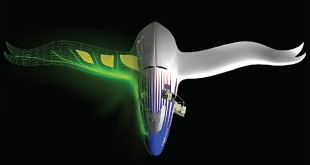Worldwide growth of photovoltaics has been fitting an exponential curve for more than two decades. During this period of time, photovoltaics (PV), also known as solar PV, has evolved from a pure niche market of small scale applications towards becoming a mainstream electricity source. The Sun blankets the Earth with …
Read More »Aramid fiber or Kevlar® Composites are verasatile materials used in both structural applications and components, in all aircraft and spacecraft
With the rapid development of the aerospace field, fiber-reinforced, resin-based composite materials have gradually replaced traditional metal materials due to their advantages of low density and high strength. An increasingly important innovation in the aerospace industry is the use of composite materials, and they have played a major role in …
Read More »Materials play critical role in Wind Turbine Blades running for long time without maintenance
Wind is a emerging as a reliable and inexpensive source of renewable energy. Globally, the average cost of wind is $83 per megawatt-hour compared to averages for coal and gas being $84 and $98 respectively. “In the USA, gas is slightly cheaper than wind but this is the only large …
Read More »New Materials enhance Artificial Photosynthesis to produce Clean Air, and Renewable Energy using more efficient and cheaper methods
Energy is the fuel for growth and life. Despite centuries of over-reliance on fossil-based energy sources with devastating effects on the planet, more environmentally friendly and renewable options keep emerging as suitable alternatives. Hydrogen generation by water splitting has long attracted attention due to its zero-emission advantage. Each water …
Read More »Niobium is one of the strategic minerals Deemed Critical to U.S. National Security and the Economy
The Department of the Interior published on May 18, 2018, a list of 35 mineral commodities considered critical to the economic and national security of the United States. These minerals have been designated as critical to the US’s national interest in part because of their potential military and industrial applications. …
Read More »DARPA’s ELM developing Living Structural Materials for self growing & self repairable smart buildings and smart military bases on demand
The cities of today are built with concrete and steel between they are responsible for as much as a tenth of worldwide carbon emissions. Before they ever reach a construction site, both steel and concrete must be processed at very high temperatures – which take a lot of energy. And …
Read More »Militaries develop Morphing military Wings and Aircrafts to provide optimal performance in reconnaissance to bombing missions
The design of aerodynamic airfoils is optimized for certain conditions. For instance, the shape of the wings of fixed-wing aircrafts are designed and optimized for a certain flight condition (in terms of altitude, speed, aircraft weight, etc.). However, these flight conditions vary significantly during the flight. Currently, aircraft are provided …
Read More »Silicon Carbide (SiC) ideal material for Armor, military systems and telescopes for space situational awareness
Silicon carbide, also known as carborundum, is a unique compound of carbon and silicon and is one of the hardest available materials. Characteristics such as relatively low thermal expansion, high force-to-weight radius, high thermal conductivity, hardness, resistance to abrasion and corrosion, and most importantly, the maintenance of elastic resistance at …
Read More »Silicon Carbide (SiC) enabling emerging power electronics revolution in Electric vehicles and Aircrafts to Military systems
Integrated circuits and power devices utilized by the semiconductor industry for the production of advanced computers, consumer electronics, communication networks, and industrial and military systems have been almost exclusively based on silicon technology. The requirements of future electronics place a great emphasis on achieving new devices with greater power density …
Read More »Geopolymer an innovative material is widely useful as construction industry to military runways, insulation material, and rocket nozzles
Geopolymer concrete—an innovative material in light of the ongoing emphasis on sustainability is a potential alternative to conventional portland cement concrete for use in transportation infrastructure construction. In contrast to portland cement, most geopolymer systems rely on minimally processed natural materials or industrial byproducts to provide the binding agents. Since …
Read More » International Defense Security & Technology Your trusted Source for News, Research and Analysis
International Defense Security & Technology Your trusted Source for News, Research and Analysis









